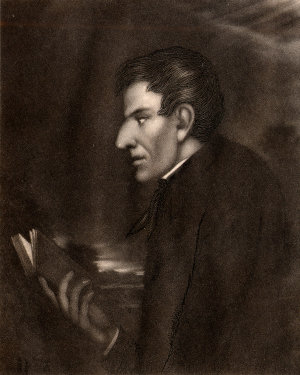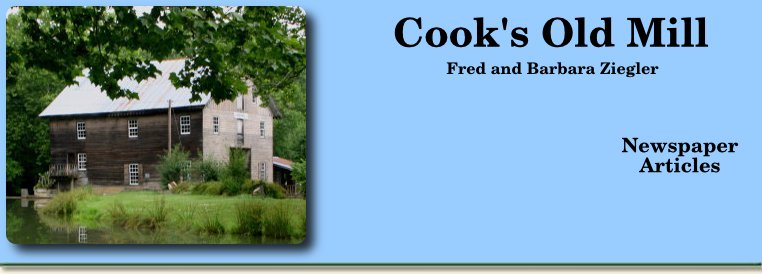Valentine Cook Jr. (1761-1821)
 In the course of researching the history of Cook's Old Mill
in Greenville, I came across an 1858 Biographical Sketch of
the Rev. Valentine Cook, A.M. by Edward Stevenson. The Cook
family, headed by Valentine and Susannah, were among the very
first permanent settlers in our area arriving in 1773 with
young Valentine and seven other children from the Shenadoah
Valley. By 1774 they had claimed a 650 acre tract immediately
west of what is now Greenville. In 1778 and 1781, their fort
on this land sheltered up to 300 settlers during tensions
with the Indians.
In the course of researching the history of Cook's Old Mill
in Greenville, I came across an 1858 Biographical Sketch of
the Rev. Valentine Cook, A.M. by Edward Stevenson. The Cook
family, headed by Valentine and Susannah, were among the very
first permanent settlers in our area arriving in 1773 with
young Valentine and seven other children from the Shenadoah
Valley. By 1774 they had claimed a 650 acre tract immediately
west of what is now Greenville. In 1778 and 1781, their fort
on this land sheltered up to 300 settlers during tensions
with the Indians.
Valentine Jr. was greatly devoted to hunting
being
a good marksman, and having at command a well-trained
pack of hounds
and he pursued wild game of every description,
from the stately buffalo to the screaming pheasant
. On one
occasion, he set out to recover his father's horses which had
been stolen by Indians. He discovered the horses tied up in
a dense thicket, and not realizing that their captors were
watching, leaned his rifle against a tree and set about to
untie them. Several Indians appeared and overpowered him.
To quote again from the biography, After carefully surveying
him from head to foot, laying their hands on his long black
hair, and looking him full in the face for some time, one of
the most elderly of the party exclaimed, 'Booh!' and added,
'Indian! young Indian!'
They returned the horses, saying
Indian won't kill Indian Boy!
This is not the first
reference to the unusual appearance of Valentine Jr.
It was during the 1780's that Valentine Jr. found his calling
as an itinerant Methodist preacher. Francis Asbury, who became
the first American bishop of the Methodist Church, visited the
area in 1781, according to Morton in the History of Monroe
County (1916). The first Methodist society in the county was
founded in 1784 on land owned by the Cooks, and eventually
deeded by his brother, the Rev. Jacob Cook, to the church
here in Greenville. The parishioners later recalled Valentine
as this youthful champion of Methodism
and as the chief
instrument of their awakening and conversion
to the new
religion.
Valentine attended Cokesbury College in Abingdon MD, the
first Methodist college in America, and he probably was in
the first class of 25 when it opened in 1787. The academic
instruction included English, Latin, Greek, Logic, Natural
Philosophy, and Astronomy, but the major emphasis was on
training students to be rational scriptural Christians
,
according to a website.
By 1788 Valentine Jr. was received into the traveling
ministry, and labored on different circuits in Virginia,
Maryland and Pennsylvania
. By 1798 he was sent as a
missionary to Kentucky where he married Tabitha Slaughter,
daughter of the governor. His declining health precluded
the rigors of the itinerant preacher's life and he
eventually settled on a farm in this area but remained
active in teaching in town and in the vicinity.
His biographer paints an unflattering portrait:
Valentine Cook was slightly above the medium height and size. There was no symmetry in his figure; his limbs, being disproportionately long, seemed more like awkward appendages than well-fitted parts of a perfect whole. He was what is called stoop-shouldered to such a degree, that his long neck projected from between his shoulders almost at a right angle with the perpendicular of his chest. His head, which was of peculiar formation, being much longer than usual from the crown to the point of the chin, seemed rather suspended to than supported by the neck. A remarkably low forehead, small, deeply-sunken hazel eyes, a prominent Roman nose, large mouth, thin lips, a dark sallow complexion, coarse black hair, with here and there a thread of gray, formed a tout ensemble in which nature seemed to have paid no regard to order, strength, or beauty.
Morton says, He was an instance of the triumph of intellect
and goodness over singular physical defects. But when he began
to preach these peculiarities were forgotten as attention was
arrested by the tones of his voice and his words.
Stevenson
explains, Among the causes of Mr. Cook's great success in the
work of the ministry, the plainness of his style and simplicity
of his manners should not be overlooked.
The principal
ground of complaint among unbelieving, impenitent sinners,
and cold-hearted, worldly-minded professors was, that they
understood him too well for their comfort and quietude
.
In the fall of 1819 (or 1820) the Reverend Valentine Cook began
a four month trip that he suspected would be his last. He wished
to see the place of his birth, to visit old friends as well as
to return to the family homestead in Monroe County. He
considered himself called by God to make this last preaching
tour. Traveling alone on horseback, he certainly covered a lot
of ground: Lexington KY, Cincinnati OH, Pittsburg and
Philadelphia PA and Baltimore MD. He preached to vast crowds
and a gracious revival followed his labors
. On the return
trip he knelt at the spot where the remains of his father
and mother were sleeping; looked at the rich valleys and mountain
summits, the crystal streams and gurgling fountains with which
he had been familiar in the days of his boyhood.
The return
trip to Kentucky took four weeks and must have been arduous.
He died shortly afterward of a bilious fever
.
Stevenson compares Valentine Cook with the great itinerant
preachers of early Methodism, including Bishop Asbury and
says, In literary, scientific, and useful attainments,
he was equaled by few, while in biblical learning and practical
piety he was surpassed, perhaps by none
.
(Watchman readers are please asked to contribute documents, photos and stories about the Cooks and the Mill for inclusion in a book I am preparing. Twentieth century material as well as earlier is desired and all originals will be copied, returned and acknowledged. The address is P.O. Box 128, Greenville 24945 and the phone number is 832-6060.)
Published in the Monroe Watchman, October 19, 2006
